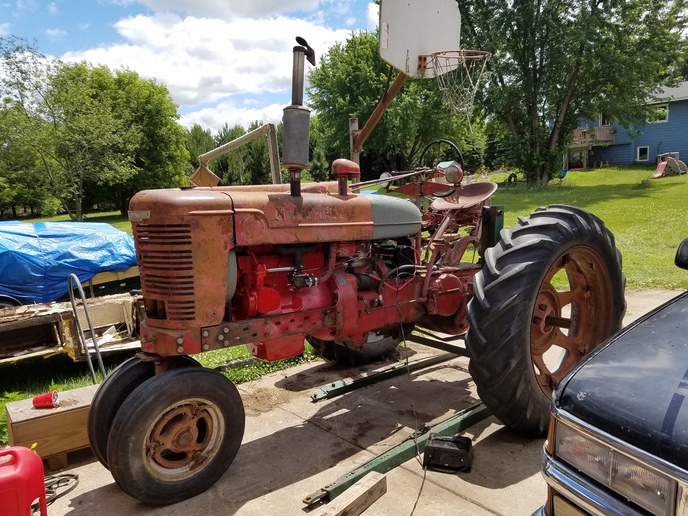Ken Christopherson
Well-known Member
Hello all!
First of all I want to give a big THANK YOU to all who have helped during this project (although it is far from over and I am sure I will still have many more questions). Today, due to everyone's patience and help, I finally got the M to breathe under it's own power after who knows how many years. I spent quite a bit of time troubleshooting a lot of things that I KNEW I had right (but better to double-triple check them), I spent so much time doing that, the most obvious (and easiest) was overlooked. I believe that 99% of my problem was the fact that the spark plug wires were out of order. Once I had it running, I started playing with the sequence and as I moved a wire it started to smooth right out. After a couple tries, I had it purring like a kitten.
Due to no sleep today (which is typical for me as an overnighter), I'm going to have to head over Friday again to retorque the head, get the tractor warm again, and readjust the valves. (Should the head be retorqued while warm, or should I do it prior to warming up for the valve reset)? I suspect that is where the hissing sound developed today after the tractor ran a while and was good and warm. From there, then, I'm going to flush the rear end and add new oil. I'm assuming it is both low and old oil in there causing a lot of the whine (and the fact that there are 70 year old gears in there). Once cleaned and topped off with new fluid it should operate well. Only thing I can see right off the bat is it needs at least one new brake band. Good thing is I don't have any leaks yet from any of the engine gaskets or connections (or the radiator) which I was really skeptical about after I took on repairing/soldering the side straps. Even the water pump isn't leaking a drop.
If anyone else has any other pointers or suggestions, I am very open to ideas. I've been coming to these forums since 1998 at the age of 12, and have sure learned a lot from many of you. Sure does feel good to be part of such a widespread and helpful group of people. I tried to post as much as I could in all of the videos I have made, and I sure hope someone else finds help in what I have put out there. I made my own mistakes, though, that is for sure.
Enjoy, and again.. Any pointers or suggestions please let me know. Otherwise, a retorque and valve adjustment is next on my list.

1947 Farmall M Episode 16 Troubleshooting and Grand Finale
First of all I want to give a big THANK YOU to all who have helped during this project (although it is far from over and I am sure I will still have many more questions). Today, due to everyone's patience and help, I finally got the M to breathe under it's own power after who knows how many years. I spent quite a bit of time troubleshooting a lot of things that I KNEW I had right (but better to double-triple check them), I spent so much time doing that, the most obvious (and easiest) was overlooked. I believe that 99% of my problem was the fact that the spark plug wires were out of order. Once I had it running, I started playing with the sequence and as I moved a wire it started to smooth right out. After a couple tries, I had it purring like a kitten.
Due to no sleep today (which is typical for me as an overnighter), I'm going to have to head over Friday again to retorque the head, get the tractor warm again, and readjust the valves. (Should the head be retorqued while warm, or should I do it prior to warming up for the valve reset)? I suspect that is where the hissing sound developed today after the tractor ran a while and was good and warm. From there, then, I'm going to flush the rear end and add new oil. I'm assuming it is both low and old oil in there causing a lot of the whine (and the fact that there are 70 year old gears in there). Once cleaned and topped off with new fluid it should operate well. Only thing I can see right off the bat is it needs at least one new brake band. Good thing is I don't have any leaks yet from any of the engine gaskets or connections (or the radiator) which I was really skeptical about after I took on repairing/soldering the side straps. Even the water pump isn't leaking a drop.
If anyone else has any other pointers or suggestions, I am very open to ideas. I've been coming to these forums since 1998 at the age of 12, and have sure learned a lot from many of you. Sure does feel good to be part of such a widespread and helpful group of people. I tried to post as much as I could in all of the videos I have made, and I sure hope someone else finds help in what I have put out there. I made my own mistakes, though, that is for sure.
Enjoy, and again.. Any pointers or suggestions please let me know. Otherwise, a retorque and valve adjustment is next on my list.

1947 Farmall M Episode 16 Troubleshooting and Grand Finale

